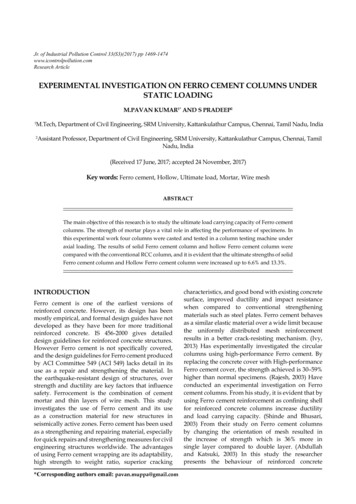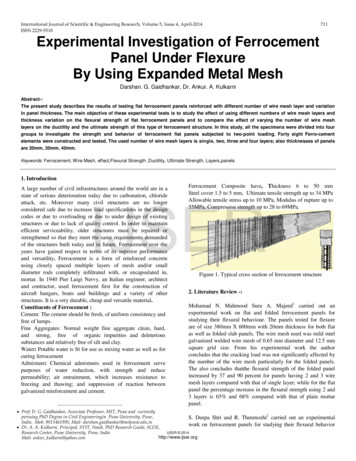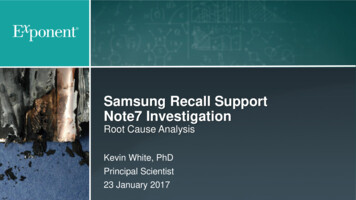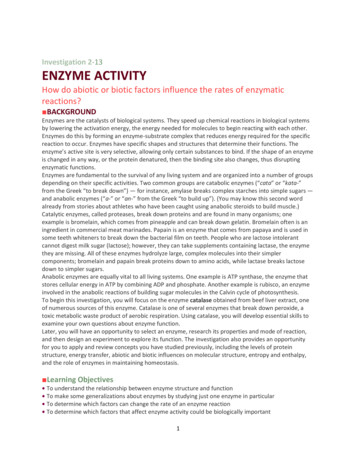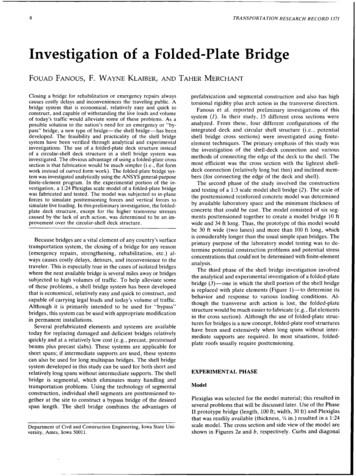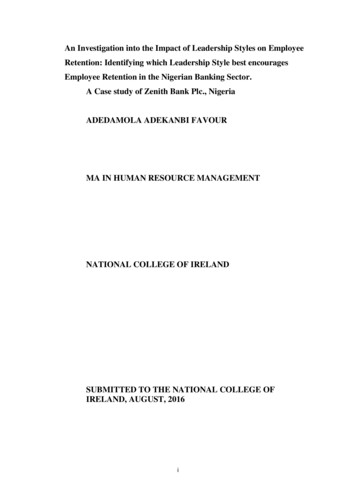
Transcription
Lab Investigation 2 - How Much Acetic Acid is in Vinegar?GUIDING QUESTIONWhat factors determine how accurate and how precise the concentration of acetic acid in vinegarcan be determined?INTRODUCTIONMany laboratories analyze consumer products to determine accuracy in the labeling of theproduct. The very common and simple technique of titration is demonstrated in this experiment.A titration is an analytical procedure in which a reaction is run under carefully controlledconditions. The stoichiometric volume of one reactant of known concentration, the titrant, that isrequired to react with another reactant of unknown concentration, the analyte, is measured. Theconcentration of the analyte is determined from the concentration and volume of titrant and thestoichiometry of the reaction between them.The experimental setup is shown in Figure 1. A buret, which contains the titrant, is calibratedso the volume of solution that it delivers can be determined with high accuracy and precision.Titrant is added to the analyte until the stoichiometric volume of titrant has been added. Thisis called the equivalence point, at which the volume of titrant delivered by the buret is read.Usually, the volume readings are estimated to the nearest 0.01 mL. The delivery of the titrant isadjusted with the stopcock on the buret. With practice, one can dispense fractions of a drop oftitrant and control the procedure well enough that replicated titrations agree within 0.10 mL. Forthis first lab, you will need your titrations to agree to within 0.50 mL.c 2012-2013 Advanced Instructional Systems, Inc. and Joi Phelps Walker. Portions c 2011 North Carolina State University 1
Figure 1: Titration setupOften, the equivalence point is determined visually with an indicator. The indicator, which isa substance that changes color near the equivalence point, is added to the analyte solution. Sincethe color change is near but not exactly at the equivalence point, the point at which the colorchange occurs is called the endpoint. Indicators are chosen so the endpoint is very close to theequivalence point.It is important to keep a titration well mixed, so the titrant and analyte can contact each otherand react rapidly. Either manual swirling of the flask or mechanical stirring can be used. You willuse manual swirling in this experiment. Remember to constantly swirl in order to ensure completemixing of the solutions.The most common type of titration is the acid-base titration. In this experiment, you willdetermine the concentration of acetic acid, HC2 H3 O2 in commercial vinegar. In this titration,aqueous NaOH is the titrant, and vinegar is the analyte. We assume that the strong base and theweak acid react completely according to the net equation:HC2 H3 O2 (aq) OH (aq) C2 H3 O 2 (aq) H2 O(l).(1)The balanced equation shows 1:1 stoichiometry, so we can write:moles HC2 H3 O2 reacting moles OH added.(2)Or more generally:moles of acid reacting moles of base reacting.(3)Moles of base can be calculated from molarity times volume (molesbase Mbase Vbase ). As areminder on concentration units, molarity is defined as the number of moles of solute in a liter ofsolution (M mol/L). This is numerically equal to the number of millimoles of solute in a milliliterof solution (M mmol/mL). It is often convenient to use this second definition of molarity intitrations and other work where small quantities are involved. There are 1000 mmol in 1 mol and1000 mL in 1 liter.For example, 10.2 mL of 0.100 M NaOH solution contains 1.02 mmol of NaOH.10.2 mL solution 0.100 mmol NaOH 1.02 mmol NaOH1 mol solution(4)Molarity of the acid can be calculated from moles divided by volume (Macid molesacid /Vacid ).In this experiment, a carefully measured volume of vinegar (Vacid ) is placed into a flask andc 2012-2013 Advanced Instructional Systems, Inc. and Joi Phelps Walker. Portions c 2011 North Carolina State University 2
the mass determined. The sample of vinegar is then titrated with a NaOH solution of knownconcentration (Mbase ), and the volume of NaOH solution required to reach the endpoint (Vbase) isdetermined. Vbase , Mbase , and Vacid are all known, so the concentration of the acid (Macid ) can bedetermined as described above. In addition, the mass of acetic acid in the sample can be determinedfrom the number of moles present and the molar mass of acetic acid (gacid M Wacid molesacid ).Finally, the mass percent of acetic acid in the vinegar can be determined from the mass of theacetic acid in the sample and mass of the vinegar solution that was titrated.mass % mass of acetic acid in sample 100mass of vinegar solution titrated(5)In the titration of acetic acid with aqueous NaOH, phenolphthalein is used as the indicator.Phenolphthalein is nearly colorless in acidic solution but turns pink at a pH of about 8. Thisindicates that the base has neutralized all the acid. As you titrate the vinegar, you will observethat the pink color is more persistent as you add more base. This is a signal to slow the additionof base, and control it carefully. The endpoint has been reached when a faint pink color persistsfor at least 30 seconds. It is easy to overshoot the endpoint. If this happens, you will have a darkpurple-pink solution, and you will have to repeat the titration, so be careful. Note the volumeyou have used, stop short of this volume in subsequent titrations, and add the last milliliter or sodropwise. Your instructor will show you how to control the stopcock of the buret to facilitate this.Note that the volume measurements in titrations are usually reported to four significant figures,so the concentrations are usually reported to four significant figures as well. Watch this in yourwork; when you calculate molar masses, make sure you have four significant figures.GOALSAs you complete this investigation you will:1Standardize a NaOH(aq) solution.2Titrate a vinegar sample with the standardized NaOH(aq) solution.3Measure the density of a vinegar sample.4Calculate the molarity and mass percent of acetic acid in the vinegar sample.MATERIALS AVAILABLE FOR USEVinegarNaOH(aq) solutionKHP - potassium hydrogen phthalatePhenolphthalein indicator10-mL pipetsBeakersc 2012-2013 Advanced Instructional Systems, Inc. and Joi Phelps Walker. Portions c 2011 North Carolina State University 3
Erlenmeyer flasks, 125 mLBuret stand with buretFunnelAnalytical balancesSAFETY PRECAUTIONSCAUTION: NaOH is corrosive. It can attack the skin and cause permanent damage tothe eyes. If NaOH solution splashes into your eyes, use the eyewash station immediately.Hold your eyes open and flush with water. If contact with skin or clothing occurs, flush theaffected area with water. Have your lab partner notify your instructor about the spill.GETTING STARTEDYour first task is to standardize the NaOH solution using solid KHP (KC8 H5 O4 , 204.22 g/mol).This means you need to determine its molarity to at least three significant figures. You will needat least three titrations that agree within 1% as described in the procedure.You have two other tasks to accomplish in the lab. You must determine the density of thevinegar solution and the molarity of the acetic acid in vinegar. The mass percent of acetic acid canbe calculated from your data.To accomplish your tasks, you will need to make very accurate volume and mass measurements.Burets and pipets are useful in accurately measuring volumes. The buret and pipet are describedin the introduction1 and videos2 . Before you begin, make sure you understand their proper use.PROCEDUREPlease print the worksheet for this lab. You will need this sheet to record your data.Preparation of Buret1Check the buret by rinsing down the sides with distilled water bottle to check if water “sheets”down inside of the buret. If water droplets are observed, the buret should be washed beforeuse. Be careful not to scratch the inner surface if you find it necessary to use a buret brush toclean it. Rinse the buret well with tap water, including the stopcock and washers. Then rinsedown the walls of the buret with deionized/distilled water.2Finally rinse the buret at least TWICE with small portions of your NaOH solution to ensurethat all water is removed. Run the solution out through the tip.3Fill the buret with NaOH solution using a mlc 2012-2013 Advanced Instructional Systems, Inc. and Joi Phelps Walker. Portions c 2011 North Carolina State University 4
4To REMOVE TRAPPED AIR BUBBLES in the tip of the buret after filling, QUICKLY OPENAND CLOSE THE STOPCOCK SEVERAL TIMES. Note: If the stopcock lines up correctlywith the buret tip, the trapped bubbles are not as prevalent. Check with the instructor if thebubble persists.Standardization with KHP1Use 1 gram of KHP. IMMEDIATELY RECORD THE MASS IN THE DATA CHART.2Use the distilled water wash bottle to ensure that all the samples have been transferred intothe flask.3Add about 50 mL of distilled water and two or three drops of indicator. The indicator phenolphthalein will be used in this titration experiment. Do not use too much indicator or youwill be titrating that molecule as well. Be consistent in using the same number of drops in allthe samples.Titration Technique1Place a sheet of white paper beneath the receiving flask to more easily observe the endpoint.2Use a split white top/black bottom card to aid in reading the meniscus. Placing the cardbehind the buret and the black line just below the meniscus darkens the meniscus for easyreading. RECORD THE INITIAL VOLUME OF NaOH SOLUTION TO THENEAREST HUNDREDTH MILLILITER ( 0.01 mL) IN THE DATA TABLE OFYOUR NOTEBOOK.3The titrant (NaOH solution in buret) can be added fairly quickly at first, but as the endpointis approached, the rate of addition should be slowed. If you are right-handed it is faster to addthe titrant with your left hand while swirling with your right (vice versa for left-handers). Asthe endpoint is approached, the pink color will persist longer and longer. Near the endpoint,rinse the flask walls down with distilled water to ensure that all the added NaOH base hasreacted.4When very close to the endpoint, suspend a half-drop of base on the tip of the buret and rinsethe drop into the receiving flask with the distilled water wash bottle. Another method used toadd a fraction of a drop is to rotate the stopcock 180 degrees very quickly; however, you caninadvertently add too much base if you do this technique incorrectly.5The endpoint occurs when the phenolphthalein changes from clear to the faintest pink color youcan see and persists for a minimum of 30 seconds. RECORD THE FINAL VOLUME OFNaOH SOLUTION TO THE NEAREST HUNDREDTH MILLILITER ( 0.01 mL)IN THE DATA TABLE. Then determine amount of NaOH solution used in the titration.6Your group must complete a MINIMUM of FOUR TRIALS and three trials must agree WITHIN 1%. You may actually do more depending upon your technique. YOU CANNOT JUST“CROSS OUT” DATA BECAUSE YOU DON’T LIKE IT; YOU MUST INDICATE THEREASON FOR DISCARDING. The reason may be obvious such as “overran endpoint” or youmay only be able to discard value based upon statistical tests3 .3./analysis/manual.htmlc 2012-2013 Advanced Instructional Systems, Inc. and Joi Phelps Walker. Portions c 2011 North Carolina State University 5
Molarity of Acetic Acid in Vinegar1Condition the buret with standardized NaOH from the previous week.2Condition a 10-mL pipet with the vinegar solution.3Measure 10 mL of vinegar into an Erlenmeyer flask and add phenolphthalein indicator.4Titrate with the standard NaOH from the previous lab.INTERACTIVE POSTER SESSIONOnce your group has completed your work, prepare a whiteboard that you can use to share andjustify your ideas. See the handout4 provided for details on this process.REPORTOnce you have completed your research, you will need to prepare an investigation report thatconsists of three sections. This report may require more than two pages with data tables. Thisreport must be typed and any diagrams, figures, or tables should be embedded into the document.Section 1: What concept and/or technique were you investigating, and how does it relate tothe guiding question? What factors determine how accurate and how precise theconcentration of acetic acid in vinegar can be determined? Describe titration and itsuse in conjunction with molar stoichiometry to determine concentration.Section 2: How did you go about your work, and why did you conduct your investigation inthis way? Specifically, what measures did you take to insure accuracy and precision?Section 3: The argument in this investigation is not so much for your result but for the validityand reliability of your data. This report should include a comprehensive data table similarto the one you used in the pre-lab exercise where you found the molarity of your base. Donot report on the base standardization process, other than to report the NaOH molarity withstandard deviation. You need to provide justification for discarding any of the vinegar titrationtrials. You should show one complete calculation of the molarity and mass % of the vinegar.Your final answer for the vinegar molarity should include a standard deviation.This third section is where you not only present your data, but use the values you obtain asevidence in your reasoning. Statements like, “see data table for values” are not acceptable!Remember: An argument is not just an answer to the question. It is a claim or conclusion supported by evidence with a rationale for why the evidence supports the claim orconclusion.4./poster/manual.htmlc 2012-2013 Advanced Instructional Systems, Inc. and Joi Phelps Walker. Portions c 2011 North Carolina State University 6
acid): Finally, the mass percent of acetic acid in the vinegar can be determined from the mass of the acetic acid in the sample and mass of the vinegar solution that was titrated. mass % mass of acetic acid in sample mass of vinegar solution titrated 100 (5) In the titration of acetic acid with aqueous NaOH, phenolphthalein is used as the .





